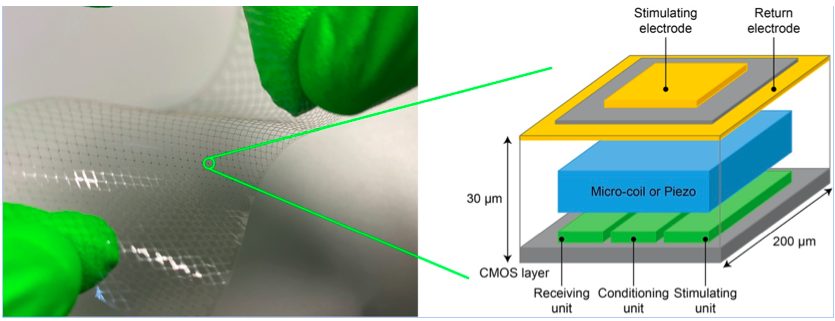The technical field of the project relates to ultra-low-power and ultra-miniaturised integrated circuits for deep brain neurostimulation.
Visual prostheses are used to revert blindness: a medical condition affecting more than 39 million people worldwide (WHO). While some of these patients are blind due to treatable or preventable causes, the remaining part (55.7%) is affected by incurable and unpreventable diseases.
The technological challenge in neurostimulation is to achieve a truly wireless array of freestanding electrodes, not relying on powered implantable external units and wired connections.
In neurotechnology, a radically new science-enabled technology would be the possibility to interact with the nervous system with smart micro-particles that can be placed in the targeted location in a minimally invasive manner. The smart micro-particles would communicate wirelessly to enable a multimodal treatment of several diseases. These ultra-small intelligent CMOS-pixels (Smart Micro Neural Dusts, SMNDs) enabling localized parallel modulation and monitoring of the neural tissue.

Project Description:
In this context, each SMND (with a later size smaller than 100 µm) is composed of three units: a receiving, a conditioning, and a stimulating unit. The SMND can be fabricated with a needle-like shape electrode to be inserted into the deep cortical layer. Compared to existing planar stimulators, the deep stimulation of the brain avoids chronical effects due to high current injection. Second, it allows to minimize the insertion trauma since it is possible to avoid blood vessel with intelligent placement strategies. This suggests exploring the feasibility of realizing such this pulse generator in order to deeply stimulate the brain with a current-mode biphasic pulse while trying to minimize both the area and the power consumption of the required electronics. Current amplitude, anodic and cathodic pulse widths and stimulation frequency are key elements in successfully brain stimulator. The circuit needs to be optimized taking in consideration the output current and the application constrains (e.g. total size, stimulating frequency, pulse width and power consumption).
Project Tasks:
- Investigate the state-of-the-art of miniaturized neurostimulators.
- Highlight the main trade-offs of possible circuit implementations in terms of size of the pulse generator, stimulating frequency, pulse widths and power consumption.
- Provide a CMOS circuit for a suitable future prototype implementation, including oscillator and biphasic pulse generator.
- Perform CADENCE post-layout simulations to assess the performance of the design.
Eligibility Requirements:
- Basic knowledge of electronics.
- Basic knowledge of CAD systems (e.g. CADENCE).
- Interest, Motivation, and Commitment to the project.
References:
- Schmidt, E. M., Bak, M. J., Hambrecht, F. T., Kufta, C. V., O’rourke, D. K., & Vallabhanath, P. (1996). Feasibility of a visual prosthesis for the blind based on intracortical micro stimulation of the visual cortex. Brain, 119(2), 507-522: https://academic.oup.com/brain/article/119/2/507/382434
- Ahmadi, N., Cavuto, M. L., Feng, P., Leene, L. B., Maslik, M., Mazza, F., … & Jackson, A. (2019, March). Towards a distributed, chronically-implantable neural interface. In 2019 9th International IEEE/EMBS Conference on Neural Engineering (NER) (pp. 719-724). IEEE: https://ieeexplore.ieee.org/abstract/document/8716998
- Piech, D. K., Johnson, B. C., Shen, K., Ghanbari, M. M., Li, K. Y., Neely, R. M., … & Muller, R. (2020). A wireless millimetre-scale implantable neural stimulator with ultrasonically powered bidirectional communication. Nature Biomedical Engineering, 4(2), 207-222: https://www.nature.com/articles/s41551-020-0518-9
- Lee, J., Leung, V., Lee, A. H., Huang, J., Asbeck, P., Mercier, P. P., … & Nurmikko, A. (2020). Wireless Ensembles of Sub-mm Microimplants Communicating as a Network near 1 GHz in a Neural Application. bioRxiv: https://www.biorxiv.org/content/10.1101/2020.09.11.293829v2.abstract